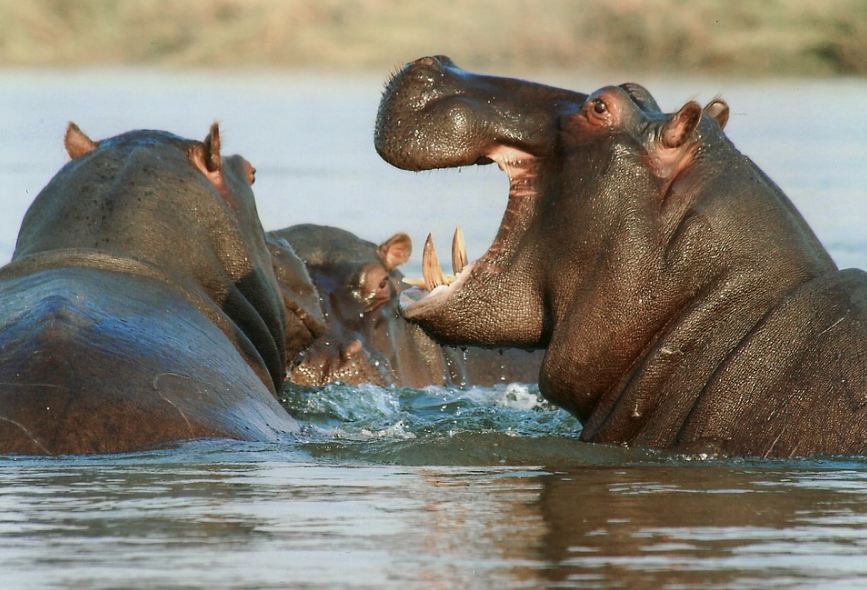Hippopotamuses or Hippopotamus amphibius are large water-loving animals that are commonly found in Africa. They are known to be the third-largest mammal living on land. These animals may the size 10.8 to 16.5 feet in length and until 5.2 feet in height at the shoulder. A female hippopotamus may weigh approximately 1,400 kilograms. Male hippopotamus, on the other hand, may around 1,600 to 4,500 kilograms.
You can usually find hippopotamuses in sub-Saharan Africa. They are known to be water-loving creatures, so they live in places where water is abundant. If you see a hippopotamus, you will notice that it submerges itself in water. That way, their skin will remain cold and moist.
Hippopotamuses are social mammals. They usually hang in groups which we call schools, pods, bloats, or sieges. A group of hippos is generally composed of 10 to 30 hippopotamuses, including both sexes. However, some groups of hippos may contain 200 members. Despite the size, a school of hippos is usually headed by a dominant male hippopotamus.
These animals, despite their sluggish image, are very aggressive. You can consider hippopotamuses dangerous animals because they usually fight and kill threats. They use their large tusks and huge teeth to fight off animals and even humans they deem a threat. According to BBC, hippopotamuses kill approximately 500 people in Africa every year- this is how deadly they are. These animals do not want other humans and animals wandering near their territory. They can most likely tear up an animal in a single bite. A hippo’s bite force is 2,000 lb. per square inch. When compared to a lion or a tiger with a 1000 lb. per square inch bite force, a hippopotamus is stronger. The jaws of hippopotamuses can open up to 180 degrees, and it is ten times stronger than that of a human’s jaw. Their lower canines can also grow to approximately one and one-half feet in length. These animals are difficult to spot, especially in water, since they can hold their breath until five minutes underwater.
When adult hippopotamuses fight each other, they tend to injure their young. It may be due to their large size and aggressive behavior. During their fight, their young are usually caught in the middle of the two adults. It will get them seriously injured or even crushed.
In 2014, a hippopotamus attacked a small boat containing Nigerian students. The hippo reportedly killed twelve children and one teacher on the small boat. In 2020, on Lake Naivasha in Kenya, 40 people were attacked by hippopotamuses. Most of them were fishermen. During this tragic event, 14 people died because of the attack. These instances show how dangerous a hippopotamus is. Experts also claimed that conflict most likely happens, especially when hippopotamuses stroll onto land to look for food.
One misconception about hippopotamuses is that they are pure herbivores. The truth is, hippos usually feed on each other and attack people too. Some experts observed that hippopotamuses eat other animals like impala, wildebeest, eland, kudu, and buffalo. They do not only eat the meat but are active predators of these other animals. Male hippopotamuses become aggressive when they sense that they are in danger. They use their aggressiveness as a defense mechanism. Female or hippopotamuses, on the other hand, attack and become aggressive to protect their children.
Very few animals can be considered predators of hippopotamuses. Only a numbered species can kill these highly aggressive mammals on their own. Even a lion cannot kill a hippopotamus on its own. It may need to go in larger groups to hurt and injure a hippo. Hyenas and crocodiles are other predators of a hippopotamus. However, because of its size and aggression, adult hippopotamuses are hardly preyed on by these animals. They usually attack the young hippopotamuses.
Some threat signs you see in hippopotamuses you need to look out for are yawning and laughing. Some tourists may find it adorable when hippos yawn repeatedly or make laughing sounds, but they must respond immediately since these are some warning signals. Remember that hippopotamuses are more dangerous than they look, and they are highly unpredictable.
Despite hippopotamuses being dangerous animals, these species also play an essential role in our ecosystem. Their dung is beneficial to the bodies of water where they live. It fertilizes and enriches the water and the fish population. When they are on land, hippopotamuses help in clearing up vegetation. Unfortunately, hippopotamuses are vulnerable species, according to International Union for Conservation of Nature. Hunting, drought, urban development, and habitat loss can threaten their survival. So we must think of ways to conserve these hippopotamuses before they get endangered and eventually get extinct.
